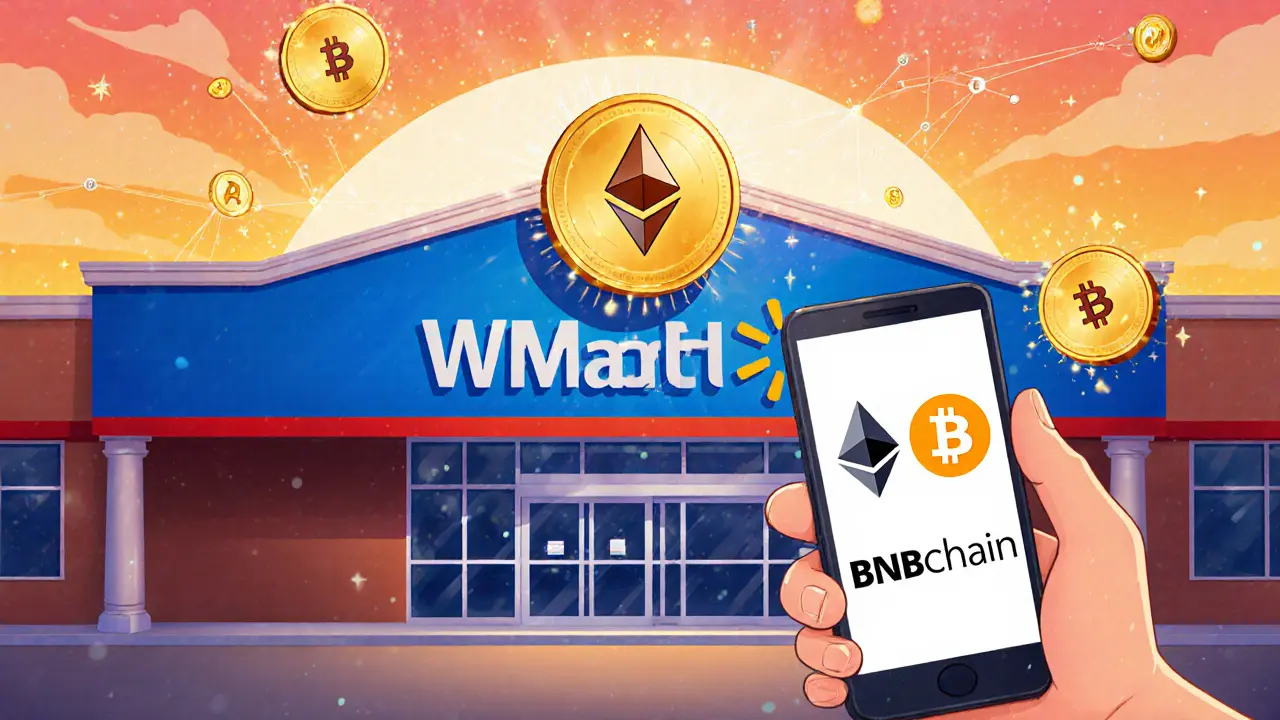
- 21 Oct 2025
- Elara Crowthorne
- 17
WMTon Premium/Discount Calculator
WMTon Value Calculator
Calculate the premium or discount of WMTon against its Net Asset Value (NAV) to determine if it's overvalued or undervalued.
Enter values to see the premium or discount calculation.
When you hear "crypto coin" and "Walmart" in the same sentence, you might wonder what the connection is. WMTon is an ERC‑20 security token that mirrors the economic performance of Walmart Inc. shares, automatically reinvesting dividends on‑chain. In plain English, buying WMTon lets you own a digital slice of the world’s biggest retailer without opening a brokerage account. This guide walks through what WMTon actually is, how it’s built, where you can trade it, and what risks you should watch.
What Exactly Is WMTon?
WMTon (ticker WMTon) is the tokenized representation of Walmart stock created by Ondo Finance a DeFi platform focused on bringing real‑world assets onto blockchain networks. The token lives on two blockchains - Ethereum (primary) and BNB Chain (secondary) - and follows the ERC‑20 standard, which means any wallet that supports ERC‑20 tokens (MetaMask, Trust Wallet, etc.) can hold it.
How the Token Mirrors Walmart’s Shares
Every WMTon token is backed by an actual share of Walmart Inc. (NYSE: WMT) held in a custodial account. The custodian holds the underlying shares, while the token provides economic rights: price appreciation, dividend payouts, and the automatic reinvestment of those dividends. This creates a compounding effect for token holders, because the dividend‑reinvestment happens on‑chain without any manual steps.
Technical Specs & Market Snapshot (Oct 21 2025)
| Metric | Value |
|---|---|
| Blockchain | Ethereum (ERC‑20) & BNB Chain |
| Contract address (Ethereum) | 0x8210…b9323B |
| Contract address (BNB Chain) | 0xa7d…3bab4c |
| Total & circulating supply | 19,685.19 WMTon (100 % circulating) |
| Current price (CoinMarketCap) | $107.74 |
| Net Asset Value (NAV) | $106.00 |
| 24‑hour volume (CM‑Cap) | $61.54 |
| Market cap | $2.12 M |
| All‑time high | $109.48 (Oct 15 2025) |
| All‑time low | $97.44 (Sep 3 2025) |
| Holder count | ≈20 active holders |
| Regulatory regime | U.S. SEC oversight; Regulation S exemption |
The numbers reveal a niche product: a market cap of just over $2 million and a 24‑hour volume that barely moves the price. Liquidity is the biggest practical hurdle for anyone looking to buy or sell large amounts.
Regulatory Framework - Why It Matters
WMTon is not a utility token; it is classified as a security. The token complies with the U.S. Securities Act’s Regulation S exemption, meaning the offering is aimed at non‑U.S. investors and is overseen by the SEC U.S. Securities and Exchange Commission, the regulator for securities markets. The legal entity that issues the token sits in the British Virgin Islands, a jurisdiction chosen for its flexible crypto‑friendly regulations.
Because of this structure, U.S. persons were restricted from the initial issuance, though secondary market trades may still involve U.S. participants under certain conditions. The regulatory overlay adds compliance costs and creates extra paperwork for holders in certain tax jurisdictions.

How to Acquire WMTon
WMTon does not sit on major centralized exchanges like Coinbase. Instead, you’ll need a Web3 wallet (MetaMask, Trust Wallet, or Binance Web3 Wallet) and access to a decentralized exchange (DEX) that supports the token. The typical steps are:
- Install a compatible wallet and fund it with ETH (for Ethereum) or BNB (for BNB Chain) to cover gas fees.
- Connect the wallet to a DEX such as Uniswap (Ethereum) or PancakeSwap (BNB Chain).
- Search for the WMTon contract address (the exact address avoids spoof tokens).
- Swap a portion of ETH/BNB for WMTon, confirming the transaction and paying the gas fee.
- Verify receipt of WMTon in your wallet’s token list.
If you prefer a guided experience, Binance’s Web3 Wallet tutorial walks through the same flow, but the token will still be purchased on a DEX, not Binance’s centralized order book.
Pros and Cons of Holding WMTon
| Advantages | Disadvantages |
|---|---|
| 24/7 on‑chain trading - no market‑hour limits | Very low liquidity; wide bid‑ask spreads |
| Automatic dividend reinvestment creates compounding returns | Regulatory complexity; must understand security‑token rules |
| Exposure to Walmart’s equity performance without a brokerage | Limited holder community - minimal support or discussion |
| ERC‑20 compatibility - works with any DeFi wallet | Potential premium/discount to NAV; price can diverge from underlying stock |
| Part of Ondo Finance’s broader RWA ecosystem, offering future upgrades | Smart‑contract risk and custodian counter‑party risk |
In short, WMTon shines for crypto‑savvy investors who already navigate DEXes and want a blockchain‑native way to hold a stable, dividend‑paying stock. It’s less suitable for traders who need tight spreads or for newcomers uncomfortable with gas fees and wallet management.
Liquidity, Premiums, and NAV - What to Watch
The token’s Net Asset Value (NAV) of $106 represents the exact value of the underlying Walmart share (plus any accrued dividends). On October 21 2025 the market price was $107.74, meaning the token traded at about a 1.6 % premium. Such premiums can widen quickly when volume is thin. Conversely, you might also see a discount if sellers outpace buyers.
Because trading happens on DEXes, price discovery relies on the few active addresses (about 13 in the last 30 days). Large sell orders can push the price far below NAV, while large buys can push it above. Monitoring the NAV versus the market price is a simple way to spot buying opportunities or avoid overpaying.

Comparing WMTon to Traditional Walmart Shares
Here’s a quick side‑by‑side view:
| Feature | WMTon (Token) | Walmart Stock (Brokerage) |
|---|---|---|
| Trading Hours | 24/7 on‑chain | U.S. market hours only |
| Dividend Handling | Automatic reinvestment on‑chain | Manual reinvestment or cash payout |
| Access for Non‑U.S. Residents | Available via global DEXes (subject to Regulation S) | May require U.S. broker or local partner |
| Liquidity | Low - tight spreads | High - tight spreads |
| Regulatory Oversight | SEC + BVI entity | SEC only |
| Custody Risk | Custodian holds shares; token smart‑contract risk | Broker holds shares; typical brokerage risk |
If you value round‑the‑clock access and automated dividends, WMTon has the edge. If you need deep liquidity or want to avoid the complexities of smart contracts, direct shares remain the safer bet.
Future Outlook and Market Trends
The tokenized‑security space is still in its infancy. Analysts at Kriptomat note that token prices often move with the broader crypto market, not just the underlying asset. That means if Bitcoin rallies, WMTon could benefit, and if the crypto market crashes, the token might dip below its NAV even if Walmart’s stock stays steady.
Ondo Finance’s roadmap emphasizes expanding tokenized U.S. Treasury and cash‑equivalent products, which could bring more liquidity and infrastructure improvements to the whole RWA platform-including WMTon. However, no specific upgrades for the Walmart token have been announced as of late 2025.
Regulatory clarity will be a make‑or‑break factor. If the SEC tightens rules around digital securities, token issuers may need to register or limit offerings, potentially raising costs or forcing delistings. Conversely, a clearer framework could attract institutional players, boosting liquidity.
Key Takeaways for Investors
- WMTon gives crypto‑native exposure to Walmart’s equity performance, with dividends automatically reinvested.
- It lives on Ethereum and BNB Chain as an ERC‑20 token, requiring a Web3 wallet and DEX for trades.
- Liquidity is thin; expect wide spreads and watch the NAV‑price premium.
- Regulatory structure (SEC oversight, Regulation S exemption, BVI entity) adds compliance layers you must understand.
- Best suited for long‑term holders comfortable with DeFi tools, not for day traders needing deep liquidity.
Frequently Asked Questions
What is the difference between WMTon and the ONDO token?
WMTon is a security token that represents a share of Walmart stock. ONDO is Ondo Finance’s native governance token used to vote on protocol upgrades and earn yield on the broader RWA platform. They serve completely different purposes.
Can I buy WMTon on a centralized exchange?
No. WMTon is only available on decentralized exchanges like Uniswap (Ethereum) and PancakeSwap (BNB Chain). You’ll need a Web3 wallet and some ETH or BNB for gas fees.
How are dividends handled?
Dividends from the underlying Walmart shares are automatically collected by the custodian and reinvested into more Walmart shares. The added value is reflected in the token’s NAV, so you never have to claim cash manually.
Is WMTon regulated?
Yes. The token is issued under a Regulation S exemption and is overseen by the U.S. SEC. The issuing entity is incorporated in the British Virgin Islands, which adds an extra layer of jurisdiction.
What risks should I consider?
Key risks include low liquidity (price can swing widely), smart‑contract bugs, custodial counter‑party risk, and regulatory changes that could affect token availability or taxation.

17 Comments
Buying a token that copies Walmart feels like turning a grocery cart into a digital lottery ticket. The promise of 24/7 trading sounds good until you realize the market is as thin as a paper bag. Dividends get auto‑reinvested, which is neat, but who controls the custodian? If the smart contract glitches, you could lose both the token and the actual share. It makes you wonder who really benefits from this crypto‑stock hybrid.
One could argue that tokenizing a stable retailer is a clever experiment, yet the liquidity crunch suggests a hidden risk. The SEC oversight adds a layer of legitimacy, but also a bureaucratic maze that most crypto fans shy away from. In the end, the idea sits in a gray zone between finance and fiction.
It is commendable that the authors have provided a thorough exposition of the WMTon token, elucidating both its mechanical underpinnings and its regulatory context. The comparative analysis with traditional Walmart shares offers valuable insight for potential investors seeking a nuanced understanding. Moreover, the attention to dividend reinvestment mechanisms underscores the token’s appeal to long‑term holders. However, the discussion could be further enriched by incorporating empirical data on transaction costs incurred on Ethereum versus BNB Chain, as gas fees remain a pivotal consideration. In sum, the article serves as an informative primer, albeit one that would benefit from deeper quantitative exploration.
WMTon is a token that mirrors Walmart shares it lives on Ethereum and BNB Chain it automates dividend reinvestment and it trades 24/7 but liquidity is scarce and spreads are wide
Looks like another gimmick to me.
Ah, the marvel of tokenizing a retail behemoth – truly the pinnacle of financial innovation. One can only imagine the exhilaration of watching a $2 million market cap oscillate by a few dollars while the world grapples with existential crises. The regulatory veneer adds the perfect faux‑respectability to an otherwise speculative pastime. Surely, institutional investors will line up once the token finally sheds its premium‑to‑NAV shackles. Until then, we shall all revel in this exquisite dance of hype and thin order books.
Don’t be fooled by the glossy brochure; WMTon is nothing more than a high‑risk, low‑liquidity trap dressed up in blockchain jargon. The custodial model offers a false sense of security while exposing investors to smart‑contract vulnerabilities. If you’re looking for real exposure to Walmart, a plain‑vanilla brokerage account will serve you far better. This token is a textbook example of crypto‑finance overreach, and I advise anyone with a modicum of common sense to steer clear.
I can see why the concept appeals to those who crave constant market access and hassle‑free dividend growth. For newcomers, the learning curve may appear steep, but the community resources and tutorials can make the journey rewarding. Keep an eye on the NAV‑price spread – it often signals good entry points for patient investors. Stay curious, stay cautious, and happy trading!
We must ask ourselves whether we’re supporting a system that prioritizes profit over transparency. Tokenizing a respectable company like Walmart could be a step toward democratizing finance, but only if the safeguards are genuine. Let’s not forget the ethical implications of bypassing traditional oversight. 🌱
WMTon tries to mix the world of stocks with the buzz of crypto, and that sounds exciting at first glance. It promises to let anyone with a wallet own a piece of one of the biggest retailers on the planet. The token sits on two blockchains which means you can pick the one with cheaper fees when you want to move it. Dividends are automatically plowed back into more tokens, so you don’t have to lift a finger to reinvest. The custodian actually holds the real Walmart shares, so the token is supposedly backed by something real. However, the whole setup depends on a smart contract that could have bugs or be exploited. If the contract fails, you could lose the token and the underlying shares could be stuck. Liquidity is another big problem because only a handful of people trade this token every day. That low activity leads to wide price gaps between what you pay and what the token is really worth. The price often trades at a premium or discount to the NAV, which can change fast. Gas fees on Ethereum add extra cost each time you buy or sell, making small trades uneconomical. The regulatory side adds another layer of paperwork that most retail investors might not understand. All of these factors mean that while the idea is novel, it carries a lot of hidden risks. In short, if you are comfortable with crypto tech and can tolerate the price swings, WMTon could be a fun experiment, but it is far from a safe, low‑risk investment.
Sure, it sounds innovative, but it’s just another way to lock retail investors into crypto volatility.
Tom, you paint a vivid picture of the pitfalls, yet I see a silver lining in the very chaos you describe. The decentralized nature can empower under‑served markets, and the auto‑reinvestment is a clever shortcut to compounding. If we embrace the volatility as a feature rather than a bug, WMTon could become a niche asset for the bold.
Paul, your succinct skepticism is as refreshing as a cold drink on a hot day – if we were thirsty for cynicism. While brevity has its merits, the underlying complexities deserve a more thorough dissection.
omg thx for the pep talk mo! i was like "whaaat?" bu now i feel more confindent to try wmt on. :) hope it goes well!!
Wow!!! This token is absolutely fascinating!!! However!!! One must consider the hidden fees, the regulatory hurdles, and the potential for price manipulation!!!
From a national perspective, promoting foreign‑listed securities on a decentralized platform undermines our domestic financial sovereignty and could expose investors to undue external risk.
Oh, the tragedy! A token that promises so much, yet drowns in its own thin liquidity! The drama of watching prices swing like a rollercoaster is simply too much to bear!